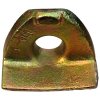JD8875
Senior Member
Picked up a new to me dump truck a few weeks ago, a 91 International 4900 with a 466 , 5/2 split and juice brakes. It was a junkyard dog with some obvious front end damage. Got that fixed and the bed needed new rails as they had been ate up from salt. Got that fixed and took it to its first job. Loaded with dirt and headed for dump site. Hit a soft spot and had to back up. When I let the clutch out the truck lugged a little let out a loud boom from the rear end and wouldn't pull itself. I figured I broke and axle shaft. Pulled both shafts and they are fine. Noticed the Dayton spoke hub had slipped inside the wheel. Believe the pop was the hub jumping past the lugs in the inside of the wheel. I'm inexperienced with Dayton wheels so my question is what's the fix/repair for this?
Thanks
John
Thanks
John

